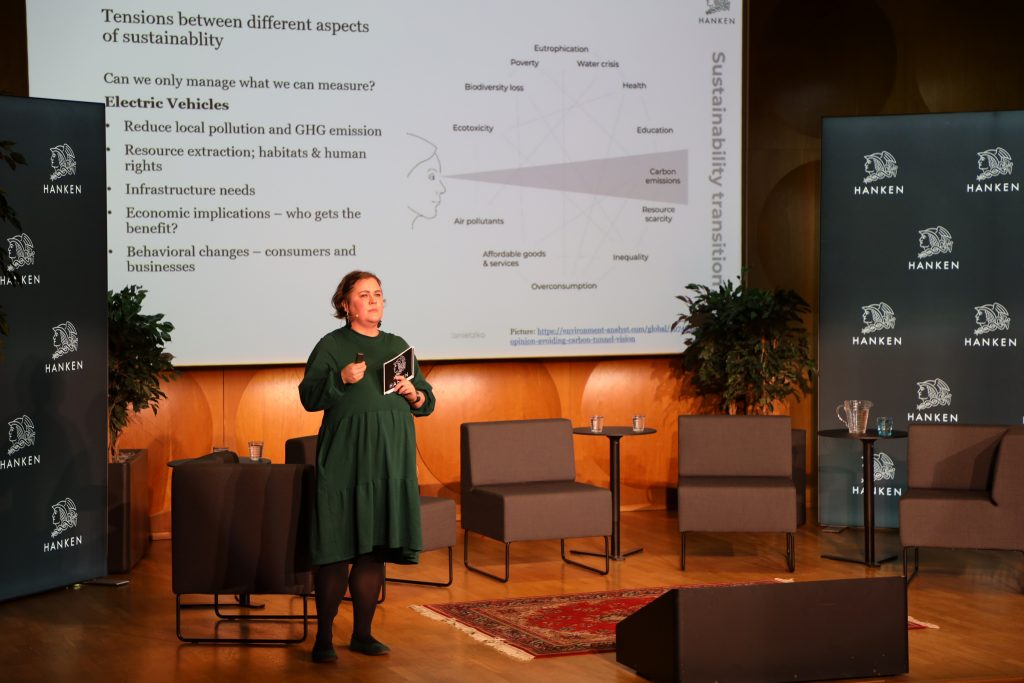By Helleke Heikkinen
Doctoral Researcher at the department of Supply Chain Management and Social Responsibility (Helsinki)

Helleke Heikkinen at Hanken Insights – Innovation for a Sustainable World
On the 25th of April the first ever Hanken Insights event was organized to provide glimpses into the research done at Hanken. This blog post is a summary of a presentation shared at the event.
Innovation is something we perceive as novel and nice. Innovations are often attributed to providing solutions for all that ail us – even grand challenges such as climate change. However, even as early as the 1930s, American sociologist Robert K. Merton wrote about the unintended consequences of the purposive action we take. In today’s rapidly changing technology environment, with innovations popping up like mushrooms at rain, it is more important than ever for us to consider what the unintended consequences might be of the many innovations brought to the market, especially when we want to mitigate grand challenges like climate change, biodiversity loss, and creating social and just opportunities for everyone globally. Even global VC firms and top University professors (HBR article) are flagging out the need for investors and innovative entrepreneurs to try to identify unintended consequences and to mitigate them early.
It is easy to guess that most inventors do not mean to cause harm. But to innovate is essentially to disrupt, and when a system is disrupted, it is not always easy to tell what the consequences might be – positive or negative. Here I do want to emphasize that unintended consequences are not always negative, they might be positive too. A classic example of an altogether unintended invention is Alexander Flemings accidental discovery of penicillin in 1928. Also, more recent examples can be found. For example, google maps started out as a map service, but has grown to be a real time traffic monitoring service that, with the help of the data of millions of users, predicts traffic congestion and thus help drivers take better routes and save both fuel and time. It might seem mundane, but on a global scale the reduction in emissions can add up to a significant amount.
So how might we then evaluate unintended sustainability consequences? Let me take an example from one of the HumLog institutes research projects WORM. Both companies and humanitarian organizations worldwide are looking for better options for using fossil-based plastics in their operations. Bioplastics are one option that has emerged, as they can reduce harmful substances and replace fossil-based alternatives. This is what we would call the intended consequence, the intention of this innovation. However, some humanitarian organizations have said they do not wish to use bioplastics because they fear bioplastics might undermine food security. How come? To answer this question, we need to investigate the unintended consequences of bioplastics.
We could start by looking into what bioplastics are made of. One alternative is starch, and another alternative is cellulose. Starch is an agricultural product and can be made from, for example, corn. If a large quantity of bioplastics is made from corn this might come at the expense of food production, especially in regions that are already vulnerable to food shortages. This happens when growing corn for bioplastics production becomes more lucrative for farmers than growing it for food. This is sometimes called a “cash crop”. As this economic opportunity is good for the farmers, food security might be impacted, and this is the concern of some humanitarian organizations that hesitate to use bioplastics in their operations. So how about cellulose then? Here the question becomes where cellulose comes from. If forests are cut down for bioplastics production, this can accelerate deforestation. On the other hand – both starch and cellulose can be made from bioproducts of both harvests and forestry, and these are great opportunities to both reduce waste, produce innovations that help the transition from fossil-based plastics, and has positive economic impact.
So, as we can see, there might be negative unintended consequences for sustainability, such as undermining food security and deforestation. On the other hand, bioplastics could offer great economic and sustainability advantages as well. This example illustrates that we can’t run for the first replacement available but need to understand the unintended sustainability consequences through research. To find research-driven solutions, one thing the WORM project is doing is exploring causal loops to understand the effects of bioplastics so that we can evaluate what the impact really is and weigh the consequences of different bioplastics alternatives. This example also shows why the supply chain perspective is so important. To be able to investigate the unintended consequences of an innovation we need to look at the whole supply chain from beginning to end.
There are plenty of other examples discussed and being researched. We need to understand if making better secondhand marketplaces for clothes makes consumers buy even more clothing when they think it is easy to get rid of unwanted items. And we need to discuss if the services created to better serve consumer needs, such as on-demand food delivery, creates negative consequences for workers in precarious situations, such as immigrants. We should also explore how we could utilize the logistics flows of last mile deliveries to provide consumers with better services to recycle and access the circular economy. These, and many other challenges are investigated at Hanken, but companies also need to act.
What can companies do? Companies can consider who is doing the innovation and what their targets are. Maybe consider if intersectionality is something that can be brought into the innovation process. Companies could also reflect on at what point in time they evaluate consequences and from what perspective. A special advisory board could be of help or using AI tools. Sometime maybe even ask the question – do we need more innovation, or do we already have the tools we need to fight for better sustainability?

Helleke Heikkinen does research in supply chain management and sustainability, currently focusing on sustainable last mile deliveries and urban logistics. She has returned to research after ten years of working in various roles within startups, technology, and investment organizations. She wants to combine her interest in cities, sustainability, and innovation, while simultaneously adopting sensemaking and paradoxical theory perspectives in her research.
